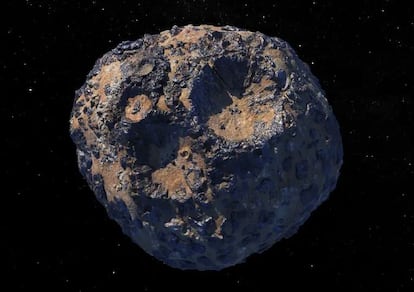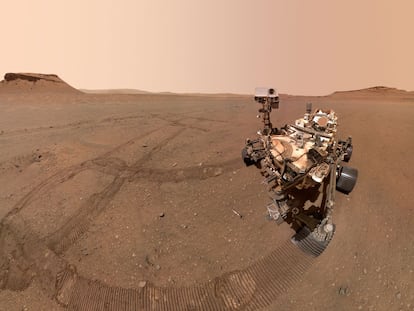Psyche, NASA’s mission to an asteroid that simulates a trip to the center of the Earth
The space probe is being launched this week, and by 2029, it will arrive at an asteroid that’s very rich in metal. Scientists aim to use the data gathered from this space rock to discover more about how the core of our planet was formed

For the first time, science is going to explore a metallic world up close. That’s the objective of the Psyche mission, which NASA is launching on October 13 from the Kennedy Space Center in Florida. A Falcon Heavy rocket from the SpaceX company will be used to propel the probe from the Earth. Thus will begin a six-year-long journey through the solar system, until reaching a strange asteroid that’s very rich in metal. This is one of the closest objects that can help us understand how our planet was formed.
When the new NASA probe reaches the asteroid (named 16 Psyche) in August 2029, it will begin to orbit it at different altitudes, with the aim of determining both its composition and its formation process. These elements — along with its specific shape and the appearance of its surface — are still unknown. It will be up to the Psyche spacecraft’s cameras and instruments to reveal the asteroid’s enigmas.
With the data that’s currently available, it’s possible to think that the asteroid is the heart of a failed planet, which didn’t form at all. No one has ever been able to directly observe the metallic core of a planet: the possibility of doing so has driven this space mission, but it’s not the only possibility. The probe could find something totally different.
The first hypothesis is that 16 Psyche is what remains of a planetesimal (the precursor of a planet), which was larger and was already differentiated: it may have had an inner iron core, separated from its rocky mantle, but then could have suffered from violent impacts that left the core exposed. Another explanation for the asteroid’s metal-rich surface: the material could have escaped from the core — through a relatively thin mantle of 15 miles — as a result of volcanic eruptions of iron. This ferrovolcanism would also explain the low density of the asteroid.
The third hypothesis — and perhaps the most improbable — describes 16 Psyche as a collection of metallic materials that accumulated near the Sun. However, if this was so, it would remain to be explained how this astronomical object could reach its current location, at a distance three times greater than that of the Earth from the Sun.
This low-cost mission (by NASA’s standards, at least, since its budget is just under $1 billion) will transport a probe the size of a small van for almost 2.5 billion miles, until it reaches the metal-rich asteroid belt between Mars and Jupiter, where it will orbit 16 Psyche. The spacecraft’s scientific instruments will make it possible to map and study the properties of this asteroid, which has a diameter of 140 miles. For instance, by observing the shape of its craters, researchers will obtain information about the impact processes, the nature of the material and, possibly, its age. This data will tell us if the asteroid was formed under conditions similar to those that brought about the Earth’s core.
The Earth’s core isn’t a place filled with dinosaurs; there’s no bizarre adventure down there, like the one imagined by Jules Verne in his classic science fiction novel Journey to the Center of the Earth. Nor is it hollow, as astronomer Edmund Halley mistakenly deduced based on the value of the relative density of the Moon, which was provided by Isaac Newton. The Earth’s core is, quite simply, made of metal. In and of itself, that makes it fascinating.
Current technology only allows us to drill about 7.5 miles deep into earth, while the core is about 1,800 miles deep. Still, this limitation hasn’t prevented us from deducing what the earth’s core is composed of, in the same way that we don’t have to cut open someone’s leg to know if they’ve broken their tibia. The physics of the process is the same, whether you want to deduce what’s inside a leg or the Earth. But, in the latter case, rather than analyzing the transmission of X-ray waves, the seismic waves of earthquakes in different parts of the planet are measured.
We also know that the Earth’s core is very hot, due to the slow disintegration of radioactive elements left over from the formation of the planet. We can also confirm that it’s subject to a pressure several million times stronger than that of the atmosphere. But knowing all of this without being able to see it or reach it doesn’t put an end to scientific curiosity, especially if there’s the slightest opportunity to observe something that even remotely resembles the Earth’s core. And this is where objects such as 16 Psyche are so relevant.
This asteroid — which economists have put a price on — isn’t cheap. It’s estimated to be worth 70,000 times the entire global economy. It’s a little metal world composed primarily of iron and nickel — possibly similar to the Earth’s core. And there lies the scientific interest, since these types of metallic asteroids are the pieces with which planets are built. To understand how this process occurs, the Psyche probe will orbit the asteroid, scrutinizing its composition, topography and the possible presence of a paleomagnetic field, which may have been fossilized in the asteroid from the moment it was formed.
The archeology of space rocks
An asteroid is a rock that orbits in space around the Sun, just like planets. However, it’s neither large enough to be classified as a planet, nor small enough to be considered a meteoroid. And, despite being referred to as “rocks,” asteroids are an extremely diverse group. To distinguish and classify the more than 100,000 known asteroids, scientists have looked at the sunlight they reflect. Depending on the chemical composition of their surface (which reveals that reflected light), they can be classified into different categories, to which a letter is assigned.
For example, C is for carbonaceous asteroids which are dark: that’s why few of these asteroids — located in the most distant parts of the solar system — are known. S is for silicates, which are shiny and, therefore, easy to see. If there’s ever an asteroid on a collision course with Earth, it’d better be an S-type asteroid! And then, there are the Ms, made of metals, such as 16 Psyche, which is a fairly large M-class asteroid.
Psyche was one of the first asteroids discovered, as reflected by the number 16 in its name. The Italian astronomer who discovered it in 1852 decided to name it in honor of the Greek personification of the soul, which takes the form of a woman with butterfly wings. With the mission that’s launched today — which bears this name — we will be able to learn new details about the history of the solar system. Thus, the knowledge that comes from this new space expedition will take us to the past and, perhaps, also to the interior of our planet.
Sign up for our weekly newsletter to get more English-language news coverage from EL PAÍS USA Edition
Tu suscripción se está usando en otro dispositivo
¿Quieres añadir otro usuario a tu suscripción?
Si continúas leyendo en este dispositivo, no se podrá leer en el otro.
FlechaTu suscripción se está usando en otro dispositivo y solo puedes acceder a EL PAÍS desde un dispositivo a la vez.
Si quieres compartir tu cuenta, cambia tu suscripción a la modalidad Premium, así podrás añadir otro usuario. Cada uno accederá con su propia cuenta de email, lo que os permitirá personalizar vuestra experiencia en EL PAÍS.
¿Tienes una suscripción de empresa? Accede aquí para contratar más cuentas.
En el caso de no saber quién está usando tu cuenta, te recomendamos cambiar tu contraseña aquí.
Si decides continuar compartiendo tu cuenta, este mensaje se mostrará en tu dispositivo y en el de la otra persona que está usando tu cuenta de forma indefinida, afectando a tu experiencia de lectura. Puedes consultar aquí los términos y condiciones de la suscripción digital.
More information
Últimas noticias
All the effects of gentrification in one corner of Mexico’s Colonia Roma
Palestinian reporter Youmna El Sayed: ‘My family told me I had to choose between being a journalist or a mother’
Russell Tovey: ‘I was advised many times not to come out, I don’t think there was many people who’d done that — and I feel really proud that I’m one of those that did’
Patagonia’s puma population soars thanks to unexpected prey: penguins
Most viewed
- The low-cost creative revolution: How technology is making art accessible to everyone
- Christian Louboutin: ‘Young people don’t want to be like their parents. And if their parents wear sneakers, they’re going to look for something else’
- US sanctions against jailed cartel leader ‘El Marro’ highlight Mexico’s lack of control over its prisons
- Families demand repatriation of bodies of Colombians who died in Ukraine: ‘This war is a slaughterhouse for foreigners’
- Liset Menéndez de la Prida, neuroscientist: ‘It’s not normal to constantly seek pleasure; it’s important to be bored, to be calm’











































